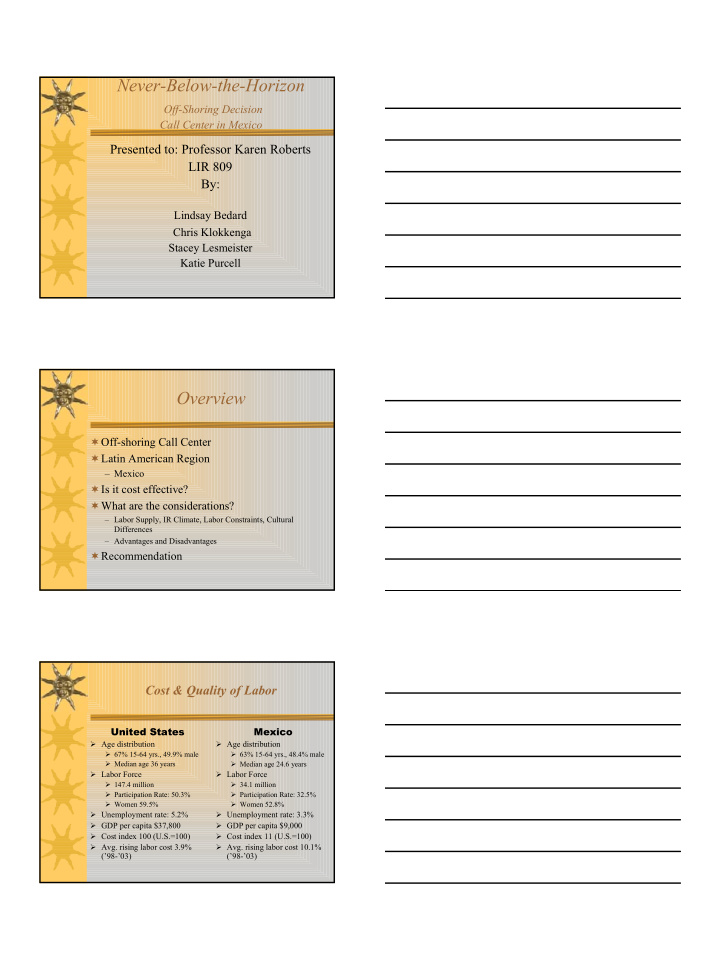



Never-Below-the-Horizon Off-Shoring Decision Call Center in Mexico Presented to: Professor Karen Roberts LIR 809 By: Lindsay Bedard Chris Klokkenga Stacey Lesmeister Katie Purcell Overview � Off-shoring Call Center � Latin American Region – Mexico � Is it cost effective? � What are the considerations? – Labor Supply, IR Climate, Labor Constraints, Cultural Differences – Advantages and Disadvantages � Recommendation Cost & Quality of Labor United States Mexico � Age distribution � Age distribution � 67% 15-64 yrs., 49.9% male � 63% 15-64 yrs., 48.4% male � Median age 36 years � Median age 24.6 years � Labor Force � Labor Force � 147.4 million � 34.1 million � Participation Rate: 50.3% � Participation Rate: 32.5% � Women 59.5% � Women 52.8% � Unemployment rate: 5.2% � Unemployment rate: 3.3% � GDP per capita $37,800 � GDP per capita $9,000 � Cost index 100 (U.S.=100) � Cost index 11 (U.S.=100) � Avg. rising labor cost 3.9% � Avg. rising labor cost 10.1% (’98-’03) (’98-’03) 1
Cost & Quality of Labor United States Mexico � Literacy rate 97.0% � Literacy rate 92.2% � Average yrs. education 12.8 � Average yrs. education 7.2 � Avg. Labor productivity � Avg. Labor productivity growth growth � 3.8% / year (’93-02) � 4.9% / year (’94-’02) � Minimum wage � National Minimum Wage Commission � $5.15/hour (most states) � Telecommunications industry � $4.50/day � Telecommunications industry � $2,650 / month � $360 / month (4003 pesos) � Hourly compensation $21.97 � Hourly compensation $2.48 � Average rates � Average rates Industrial Relations Environment � Ministry of Labor and Social Welfare (STPS) – Monitors compliance and implementation of FLL – Deals with employment and social protections of workers, conditions of employment, and labor relations – Social Security Policy – ILO Industrial Relations Environment � Mexico is highly Unionized – With about 20% of the workforce – The Unionization rate is nearly twice as high 2
Industrial Relations Environment � Congress of Labor (CT) – CTM (Confederation of Mexican Workers)- claims to have 5.5 million members, but realistically about 4 to 4.5 million – CROC (Revolutionary Workers and Peasants Confederation)- claims 2 to 4 million members, but in actuality 1 to 1.5 million � National Union of Workers (UNT) – Alternative to the CT Industrial Relations Environment � Many other small federations and unions with in the country � Corruption still occurs Anti-Discrimination � -Employers can not discriminate on the basis of race, sex, age, religious or political beliefs, or social standing 3
Safety and Health -Employer responsibility to have hire labor inspectors to make sure hazard regulations are complied with -Employee entitled to all necessary medical care, regardless of fault -Employers obligated to modify work place for the safety and health of their employees Overtime -Standard work week is six-days/48 hours -Overtime that is paid for first 9 hours over 48, for working on a legal holiday, Saturday, or Sunday is twice the hourly wage -Overtime for beyond 9 hours over 48 is triple the hourly wage Child Labor -Minimum legal working age is 16, but only with parental consent and a permit from the Secretary of Labor and Social Welfare -Minors (under 18) are not allowed to work in areas of potential health risk, after 10:00 pm, or any overtime 4
Minimum Wage -About $4.50/day -Set annually by The National Minimum Wage Commission -Varies by region and sometimes industry -It is supposed to be able to sustain a person with a basic standard of living -Many employers pay above the minimum wage Enforcement of Labor Laws -Laws are supposedly more strictly enforced than in the U.S. -Constitution and the Federal Labor Law (FFL) favor unionization Cultural Issues To Consider � Is there a cultural fit? – Large cities in Mexico have similar infrastructure as large cities in the United States – Many large cities in Mexico have become “Americanized” – Large spread of income distribution among Mexican citizens 5
Composition of Workforce � The call center will employ English-speaking Mexican workers – English is a valuable skill, thus employees with this skill will be compensated higher – Inability to take advantage of cheap labor � Call center employees will be mostly part-time workers – Students – Rotation of workers – High turnover Cost-Benefit Analysis � Costs � Associated Benefits – Minimum wage rate set – Ability to take advantage each year nationally, may of lower wage rates vary by regions – Minimum wage currently – Costs of employing set at $4.50/day in Mexico workers is less due to versus $5.15/hr in US lower Minimum Wage – Standard work week in – Reduction in costs of Mexico is 48 hours versus overtime pay 40 hours in US Offshore Call Center in Mexico � Advantages � Disadvantages – NBH will realize cost – Possible language barriers savings – Similar infrastructure – US customers do not like – Cultural fit dealing with offshore call – Americanization of large center representatives Mexican cities – NAFTA – Inability to take advantage – Government incentives due of cheap labor due to to job creation required skill set – Enforcement of labor laws – are they really enforced? 6
Off-shore Call Center Recommendation and Decision � Off-shore call center in a large Mexican city � Take advantage of cheaper labor and government incentives � Recruit and select qualified English speaking candidates 7
Recommend
More recommend